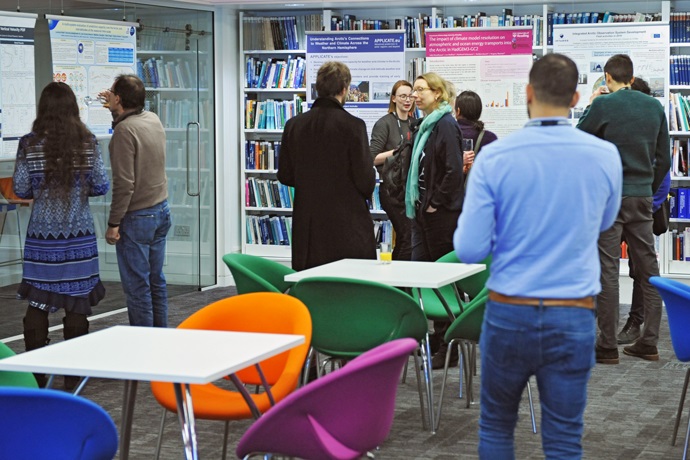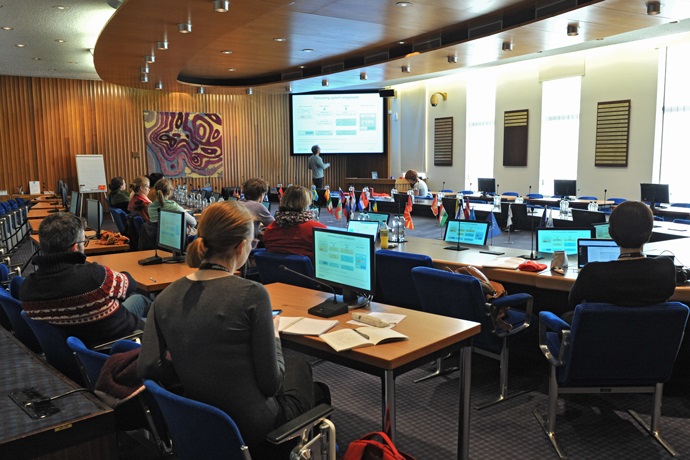

Professor Thomas Jung from the Alfred Wegener Institute, Helmholtz Centre for Polar and Marine Research (AWI) opened the meeting.
Some 70 scientists reviewed 'exciting first results' at the second General Assembly and an early career event of the EU-funded APPLICATE project on polar prediction at ECMWF from 28 January to 1 February 2019.
ECMWF is one of 16 APPLICATE partners from nine European countries. The four-year project started in November 2016.
The introductory talk by project coordinator Prof. Thomas Jung (AWI) was followed by 23 talks on the various streams of work undertaken to achieve APPLICATE’s objectives.
The overarching goal is to develop enhanced predictive capacity for weather and climate in the Arctic and beyond, and to determine the influence of Arctic climate change on northern hemisphere mid-latitudes, for the benefit of policy makers, businesses and society. Specific research objectives of APPLICATE include:
- observationally constrain models using advanced metrics and diagnostics
- develop enhanced weather and climate models and enhance the capacity to predict northern hemisphere weather and climate
- determine the impact of Arctic climate change on mid-latitudes through atmospheric and oceanic linkages
- contribute to the design of the future Arctic observing system.
The meeting was also an opportunity for early career scientists to present their research and, in the second half of the week, take part in a range of sessions designed to support their work and careers.
Exciting results half-way through the project
“Just over half-way into the project, APPLICATE is well on track: exciting first results were discussed and we expect to make further substantial progress over the next year,” says Irina Sandu, the coordinator of polar prediction activities at ECMWF.

A poster session provided opportunities to showcase ongoing research.
Many of the talks were given by early career scientists. One of the findings to date, reported by ECMWF scientist Heather Lawrence, is that existing observing systems in the Arctic improve forecast skill in the region in the short and medium range and in the mid-latitudes in the medium range.
“Interestingly, it appears that a better use of existing satellite observations, in particular over snow and sea ice, is probably just as important as new observations,” Heather notes.
In terms of modelling, ECMWF scientist Gabriele Arduini presented progress on a new multi-layer snow scheme being developed at ECMWF.
“Our results suggest that a better description of snow physical processes improves the representation of the snowpack in our numerical weather prediction (NWP) models and reduces systematic errors in short-range wintertime forecasts of minimum temperature over the Arctic,” Gabriele says.
Other topics included atmospheric interactions between the Arctic and the mid-latitudes (Kunhui Ye, AWI); improving the representation of sea ice variability (Eduardo Moreno-Chamarro, BSC); and the northern hemisphere atmospheric response to Arctic summer sea ice loss (Svenya Chripko, CERFACS).
All presentations are available on ECMWF’s website.
The last two days were dedicated to supporting the work of early career scientists, which is also part of APPLICATE’S objectives.

The APPLICATE General Assembly was followed by a series of training sessions for early career scientists.
ECMWF’s role in APPLICATE
ECMWF is one of the main partners in APPLICATE as part of its wider polar prediction work.
“The Arctic region poses a range of challenges for NWP because model errors are large, in-situ observations are sparse, and satellite observations are more difficult to use than in other regions because of ambiguous signal properties, in particular over snow and sea ice,” Irina says.
One of the Centre’s contributions is an open data portal providing ECMWF analyses and coupled atmosphere–ocean–sea ice forecasts from 2017 to 2019 to the international community.
Within APPLICATE, ECMWF’s work on a multi-layer snow scheme aims to improve the representation of snow-to-atmosphere coupling. This is important for accurate forecasts of near-surface temperature and the evolution of snow cover.
Another focus of ECMWF in APPLICATE is on the benefits of coupling between the ocean, the atmosphere and sea ice.
As part of APPLICATE and the World Meteorological Organization’s Polar Prediction Project, ECMWF is also contributing to an international intercomparison of NWP models at supersites in the Arctic. This will help the Centre to evaluate coupled processes and identify model errors.

The workshop was attended by 69 scientists from across Europe.
More information on APPLICATE
The APPLICATE project is funded by the European Union’s Horizon 2020 research and innovation programme, grant agreement No. 727862.
The 16 APPLICATE partners are based in nine countries: Belgium, France, Germany, Iceland, Norway, Russia, Spain, Sweden and the United Kingdom. The project is coordinated by the Alfred Wegener Institute, Helmholtz Centre for Polar and Marine Research (AWI) in Bremerhaven, Germany.
For more information on APPLICATE, visit the APPLICATE website.
